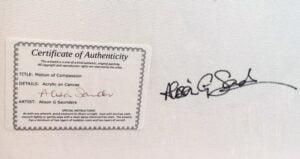Your signature is more than just your name on a painting; it’s the final mark that authenticates your work and connects you to the viewer. Getting it right is a crucial part of your practice. Here’s how to ensure your signature complements, rather than complicates your art.
The Golden Rule: Always Sign Your Work
The biggest mistake is to leave a piece unsigned. Your artwork is a testament to your skill and vision at a specific point in your journey. Own it. Be proud of your progress. An unsigned piece is anonymous and harder to trace back to you, potentially losing you future recognition and sales.

Location, Location, Location
The traditional place to sign an artwork is the front, in the bottom right-hand corner – it’s where collectors expect to find it. However, there’s one compelling exception, particularly for abstract artists like me: signing the back.
By signing only the back, you give the buyer complete freedom to hang the work in whichever orientation they feel works best, without a signature dictating “up” or “down.” If you do this, always use a permanent marker and consider attaching a certificate of authenticity. Never sign the frame or mount, as these can be replaced, losing your mark forever.
Style and Size: Blend, Don’t Dominate
Your signature should be an integrated part of the composition, not a distraction.
- Size: Avoid making it too large or bold. It should be discovered, not dominate.
- Colour: Choose a colour that harmonises with the palette of the piece. A harsh black mark can easily destroy a delicate atmosphere.
- Style: Whether you use your full name, initials, or a custom chop stamp (a beautiful Japanese-inspired method), ensure it’s consistent and legible. Your signature is your brand.
A Note on Identity
Some artists, particularly women, have historically used their initials, or even pseudonyms, to circumvent gender bias. While the art world is evolving, slowly, it’s a personal choice. Consider also your online presence; adding a middle initial (like I did, becoming Alison G. Saunders) can help collectors find you easily in a crowded digital space.
Your signature is your seal of approval. Make it intentional, make it professional, and make it a proud part of your artwork’s story.
NB I do not get paid to endorse any people or brands mentioned in my blogs. If you enjoyed this post, please like, share and follow me. Sharing, liking and following raises the algorithms in my favour.
Thank you for your support.
